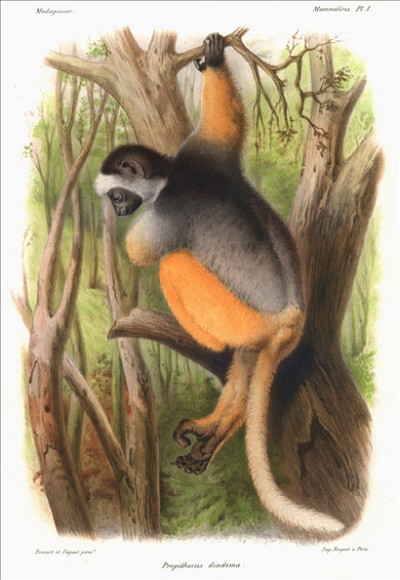 |
| Illustration of a Diademed Sifaka |
Deforestation is a global
problem. In other words, there is hardly a single area on Earth that has not
been affected by deforestation in some way. However, there are some places on
Earth where deforestation in just that one area becomes a global problem. One
of these places is the island of Madagascar off the coast of Africa. Roughly
90% of the reptiles on Madagascar are found nowhere else on Earth. Twenty-nine
species of the world’s lemurs are endemic to the island. Additionally, 80% of
the plant species on the island are endemic, including the rosy periwinkle,
which is used in the treatment of leukemia. Rampant deforestation puts all of
these species in danger.
Problem deforestation in
Madagascar began more than 100 years ago. Economic woes forced the Malagasy to
clear forests for agriculture. They used the slash and burn method to clear
large areas of forests for the growing of crops like rice and coffee. Some
estimates say that roughly 70% of Madagascar’s primary forests were clearcut
between 1895 and 1925. Most of the deforestation that took place at this time
was done illegally. Since that time, commercial logging and the use of wood for
fuel have also contributed to the deforestation in Madagascar. Also since that
time, we have seen what kind of impact that this is having on the local animal
species. The following are just a few of the island’s endemic animals that are
threatened due to habitat loss.
The Golden bamboo lemur is
endangered primarily because of deforestation. They live in mid-altitude
rainforests on the island. Their diet consists primarily of giant bamboo, which
is also subject to being chopped down.
The Golden-crowned sifaka is an
endangered lemur species. Their endangerment can be linked to both mining and
deforestation. They dwell in the gallery, semi-evergreen and dry deciduous
forests of Madagascar. Their diet consists primarily of fruit, seeds, leaves
and flowers.
The Greater bamboo lemur is
critically endangered due to food source and habitat destruction. They subsist
almost entirely on giant bamboo. They dwell in the primary rainforests of the
island.
The Greater big-footed mouse
dwells in the dry deciduous forests of Madagascar. They are endangered due to
habitat loss. They eat fruit, seeds, berries, roots and stems.
The Diademed sifaka is
endangered primarily through deforestation. They live in both the primary and
montane rainforests of the island. Their diet consists primarily of leaves,
seeds, fruit, shoots and flowers.
The Indri is yet another lemur
that is endangered because of deforestation. They dwell in the rainforests of
central eastern and northeastern Madagascar. They dine on leaves, flowers and
fruit.
The Malagasy giant rat lives in
the coastal dry deciduous forests of the island. They are endangered due to
deforestation and the introduction of invasive black rats. They subsist
primarily on fruit, seeds, sapling bark, roots and tubers that they forage off
of the forest floor.
You’ll notice that all of these
animals rely on the forests, not only for shelter, but also for food. And these
are only just a scant few of the endemic species on Madagascar that do so. If
deforestation continues the way it has been, not just some, but all, of the
endemic species will become endangered. It would become inevitable. Even marine
life is threatened because of soil erosion, which is directly linked to
deforestation. There is good news, however. Conservationists are working very
hard to protect the habitat that is left. They have even seen some success, despite
the fact that it is very hard to save anything when people can make money off
of its destruction.
Sources
Greater Big-Footed Mouse,
retrieved 2/12/10, arkive.org/greater-big-footed-mouse/macrotarsomys/range-and-habitat.html
O’Connor, Alane, what are the
historical causes of deforestation in Madagascar?, retrieved 2/12/10,
colby.edu/personal/t/thtieten/def-mad.html
No comments:
Post a Comment